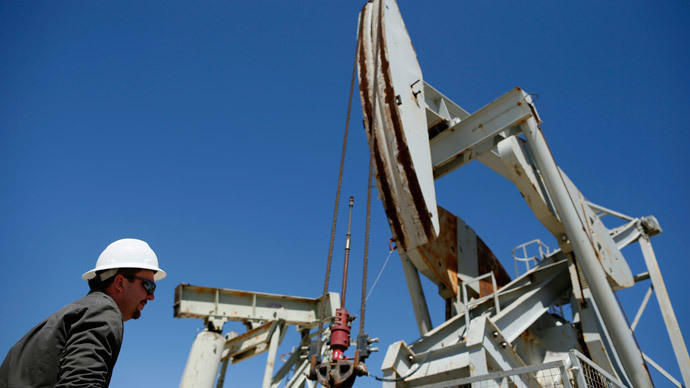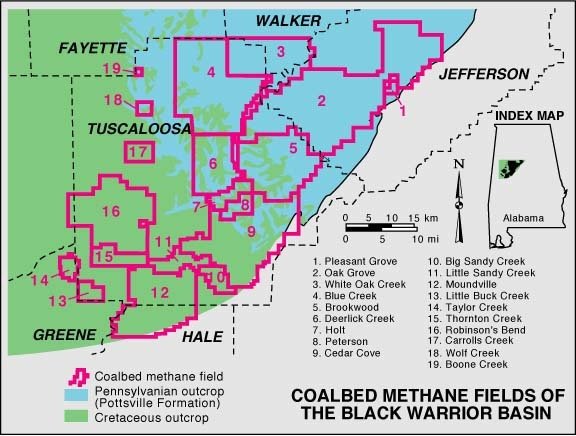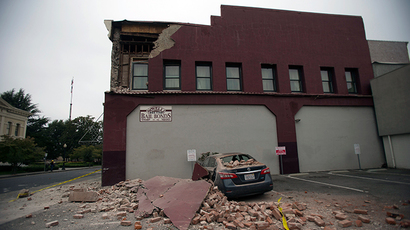Fracking to blame? Alabama earthquakes occurring near shale-gas developments

More than a dozen minor earthquakes have struck western Alabama’s Greene County since November.
The area is near the Black Warrior Basin, where thousands of hydraulic fracturing natural gas wells have been operating in recent years.
The Associated Press reported Sunday that Greene County has had 14 notable yet inexplicable seismic events since November 20, starting with a magnitude 3.8 quake 10 miles northwest of Eutaw. The latest was a magnitude 3.0 earthquake on June 6.
"It is interesting that recently there has been more activity there than in the last four decades," Sandy Ebersole of the Geological Survey of Alabama told AP.
Geological experts are now using a seismic monitor to gather information on the quakes in hopes that they can understand the exact cause.
READ MORE: Oil & gas execs ‘pressured’ Oklahoma geologists not to reveal fracking-quakes link
Some wonder if hydraulic fracturing, or fracking, in the area is the source of unusual seismic activity, as the oil and gas extraction process has been the cause of quakes in other areas of the United States, including Oklahoma and Ohio.
In the fracking process, large volumes of highly pressurized water, sand, and chemicals are blast into layers of rock to release oil or natural gas. Fracking fluid includes chemical substances that the energy industry and many government officials will not name, yet insist do not endanger human health, despite findings by many scientists and environmentalists to the contrary. After use, toxic wastewater left over from fracking is either stored in deep underground wells, disposed of in open evaporation pits, sprayed into waste fields, or used again.
Fracking has been linked to groundwater contamination, exacerbation of drought conditions, and a host of health concerns for humans and the local environment.
In April, scientists with the US Geological Survey (USGS) said the increase in seismic activity throughout the country is mainly due to the oil and gas industry injecting wastewater deep underground, which can activate dormant faults.
Expert conflict of interest?
Nick Tew, Alabama’s state geologist, told AP that no oil or gas is currently being produced in the area where the quakes occurred in Greene County, and so there has been no recent wastewater disposal either.
Tew is the head of both the Geological Survey of Alabama and the State Oil and Gas Board of Alabama, the latter of which regulates drilling operations in the state.
According the biography he submitted to Shale UK for a speaking event at a March 2015 conference seeking to boost shale drilling potential in the UK, Tew was the former head of American Geosciences Institute, an organization that downplays fracking risk, and vice-chairman of the Interstate Oil and Gas Compact Commission. He currently serves on the National Petroleum Council.
Greene County is situated near the Black Warrior Basin, where natural gas was first drilled for in the 1970s. It remains an epicenter of regional oil and gas drilling.
"As of April 2012, there are 5,537 coalbed methane (CBM) – aka natural gas – wells operating in the Black Warrior River watershed,"according to the Black Warrior Riverkeeper, which describes itself as “citizen-based nonprofit organization dedicated to improving water quality, habitat, recreation, and public health throughout our patrol area, the Black Warrior River watershed.”
Fracking is used throughout the basin region with fluids which "create underground fissures in targeted coal seams and surrounding rock and shale, and phenolic resin-coated sand holds the fissures open, allowing natural gas to flow toward the surface," according to Riverkeeper.

"Tens of thousands of acres in the Black Warrior Basin are leased for drilling wells to access coal seams where the gas is trapped, creating a massive network of roads, well pads, and pipelines," they go on to say, noting "Erosion from these areas is a documented source of sedimentation, choking streams and reservoirs throughout the basin."
More than 2.1 trillion cubic feet of coalbed gas has been produced from the basin, the Geological Survey of Alabama wrote as late as 2012.
"The Black Warrior basin is a cradle of the modern CBM [coalbed methane] industry that has provided a wealth of experience and has guided CBM development around the globe," the Geological Survey of Alabama added. Greene County represents the southwest portion of the map below.
"Annual gas production has been between 105 and 121 billion cubic feet since 1993," according to the Geological Survey of Alabama, "and although the basin is considered mature, exploration and drilling operations are highly active."
Greene County -- shaded in purple, within the Appalachian Thrust Belt in the map below -- also sits atop Devonian-age shale, which has much potential for drilling, according to the Geological Survey of Alabama.
"Natural gas has been produced from Devonian shale since the 19th Century, yet the potential for gas production from Devonian shale in Alabama is just beginning to be realized," the Geological Survey of Alabama claims
The increase in earthquakes in the US has rocked once stable regions in eight states: Alabama, Arkansas, Colorado, Kansas, New Mexico, Ohio, Oklahoma, and Texas.
Oklahoma has been the most heavily affected state recently, experiencing more magnitude-3 and higher earthquakes in 2014 than California – the most seismically active of the lower 48 states.
The Oklahoma Geological Survey said in April that the rise in the number of quakes in that state is “very unlikely to represent a naturally occurring process,” since they are occurring in the same area that has seen a huge jump in wastewater disposal over the past several years.














